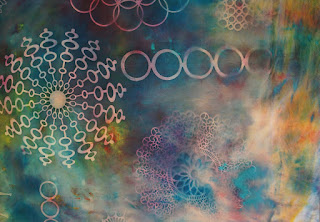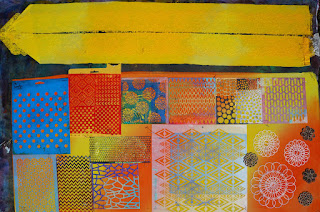I finally made time to do some sun printing last weekend. I wanted to do some large pieces of fabric, which was a challenge. I also wanted to do multiple layers of paint to get some depth to the patterns.
Here is my setup. I lay my fabric out on an insulation board (from the hardware store). My board is about 4' long x 3' wide. My fabric is 6' long x 3-1/2' wide. For the first layer I did half the fabric and after it was painted and dried, I did the other half.
I find it easier to lay dry fabric on the board and wet it with a spray bottle, than to dampen the fabric first. I need to try to get the fabric as smooth as possible and it is much easier doing it section by section with a spray bottle. The fabric was pre-washed and dried in the dryer. I am using 100% cotton sheet.
Here are my Setacolor paints. I keep them in these plastic containers with screw-top lids. I water them down about 50/50 (half paint/half water), screw the lid on and shake it. Make sure the lid is on tight.
Here is a collection of lace, doilies, stencils, etc to sun print with.
For this piece I layered two pieces of fabric. The bottom layer usually is more muted than the top, after they have been painted and dried. I often do this as it's like getting two pieces for the work of one.
For this first layer, I used two yellows and an orange. I used lace and lace doilies to sun print. They were very soft sun prints, due to the light paint colors.
This is after doing both sections of fabric, size is roughly 6' x 3-1/2'.
Here is a close-up of a doily print.
For the second layer, I painted on red, more orange, and fuchsia. I used stencils and plastic doilies with this layer.
I wanted to soften up the color transitions, so for the third layer, I did what I call Puddle Painting. I pour multiple paint colors onto a plastic lid (from a storage container) and smush my wrinkled up damp fabric into the paint. I will squeeze the fabric a little, unwrinkle it, then ball it up again and smush it into the paint again. I usually only have to do this twice to get good coverage on most of the fabric. I don't want to completely cover up the previous layer. I recommend wearing gloves. I puddle painted the entire fabric and had it span two different boards (since the fabric is longer than the boards). You can see my blog post demonstrating puddle painting
here.
Here is the final piece, ironed. I think it's hard to tell how big the fabric is in these pictures. The round stencils are about 12" to give you a sense of scale.
Close up of the final piece.
As I said above, I put a second piece of fabric underneath when I painted the first layer. The colors were a muted yellow and orange on this bottom piece. I just added one more layer of paint to it, to create a more multi-colored piece. I used the puddle painting technique and used primary colors, cobalt blue, red, and yellow. I also included some fuchsia and some opaque turquoise. Setacolor opaque colors will not sun print, but I like this turquoise color and it adds some pop.
Here is the final piece and I think it is delicious.
Here are some close-ups.
I also like the back side, the colors and patterns are more subtle.
Back, close-up.
I think I will be combining some of the front and some of the back in my project.
But I'm not done sun printing.
I did a similar orange and yellow first layer on a smaller piece of fabric. This piece is about 2' x 3'. I layered a lot of smaller stencils on this piece.
I also did a narrow band of fabric that I put lace on top of.
Both these have a top and bottom layer of fabric.
Here is the top layer, after sun printing. I left this piece as is and did not print over it.
Here is the bottom layer.
The bottom layer I printed over using ultramarine blue and more stencils. I do not like the orange and dark blue contrast. I am not sure what I will do with this piece. Maybe another layer?The area to the right where it was folded up it actually quite interesting.
For the narrow band, I cut it in half and overprinted one of them with red and fuchsia, with stencils.
Close-up. The dark yellow section does have the lace pattern printed on it, it is just hard to see in these pictures. As you can see, the section I over-painted with red and fuschia is quite different depending on the color of the underlayer. The part that looks orange was the darker yellow color like the piece above it.
Here is the lace and doilies I sun printed with. I did paint them some more after printing.
I also painted some cheesecloth, a Japanese inspired 60's fabric, and polyester dress lining. There is a certain kind of polyester that prints the wrinkles in the fabric really well.
More cheesecloth and the Japanese inspired 60's fabric.
I started the large fabric pieces, which were cotton sheets, with the sewn edges still on. They were preventing the fabric from being really flat on the boards, so I cut them off after applying the paint. I will be keeping them to incorporate in my project.
But wait, there's more. When I have my sun printing supplies out, I start looking for things to paint. I made some large fabric collage pieces previously, and decided to sun print a few. These were puddle painted. This is a big one, roughly 3' x3'. I used a few stencils on it as well (circles and plastic doilies).
Before:
After:
This one is 12" x 12". I dripped a little opaque turquoise on afterwards. Puddle painted with no sun printing.
This one is 12" x12". I think I may work on leaving more white on future pieces. Puddle painted with no sun printing.
And I just thought I'd add a few pictures of flowers from my yard. The back yard is more weeds than grass, but I do have these lovelies.
 |
| Northern Hibiscus |
 |
| Surprise lily |






















